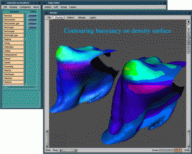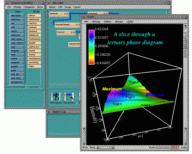IRIS Explorer - Get ready for Release 3.5!
by Jeremy Walton, NAG Limited
The new version of IRIS Explorer (External), the leading visualisation toolkit from NAG (External), is Release 3.5. This contains many internal enhancements and a large number
of new modules, many of which are based on other NAG products such as the
well-known NAG numerical library (External) and the NAG Graphics Library (External). Regular readers of Render will recall some of the new modules being previewed in earlier issues (for example, the line integral convolution module in
the last issue, the vector smoke module in Issue 4, and the extended pyramid
modules in Issue 3). These are all featured in Release 3.5.
The major internal enhancement is the updating of the underlying version
of Open Inventor to 2.1. IRIS Explorer is built on top of Open Inventor (External), the object-oriented, OpenGL-based 3D toolkit from Silicon Graphics (External), which makes it a natural authoring tool for scenes in Open Inventor (in
fact, the IRIS Explorer geometry data type is an Inventor scene graph) or VRML (External), the Inventor-based language for 3D on the World Wide Web. Open Inventor 2.1 (External) is a performance release, with rendering speedups of between 20% and 400%,
and IRIS Explorer 3.5 reflects these enhancements in its Inventor-based
modules such as Render. In addition, it incorporates all of the other improvements in Open Inventor
2.1, such as full VRML support, a new locate highlighting node and a new
all-in-one geometry manipulator. Finally, the Render module has been completely rewitten for this release to incorporate new
features such as 3D cut and paste, improved scene picking, editing and saving
and software rendering via X. This latter option means that IRIS Explorer
can now run on any display, even those that do not support OpenGL.
Other internal enhancements include the incorporation of NAG Library interpolation
routines into the system library. The NAG routines use a state-of-the-art
algorithm, which results in faster, more accurate interpolation for all
modules that make use of this facility.
 Besides adding new modules, new functionality has been incorporated into
existing modules. For example, the popular LatToGeom module can be used to produce a sheet from a 2D lattice which is coloured
according to the data values of another 2D lattice. In older versions of IRIS Explorer, this colouring was done on a per-vertex
basis, with the colours being smoothly interpolated between points on the
surface. This functionality has been complemented in Release 3.5 with the
option for solid contouring on the surface, which can be used to rather
striking effect. In a similar way, the IsosurfaceLat module, which can produce an isosurface through a 3D lattice coloured according
to the local value of another 3D lattice, now features solid contouring
in Release 3.5.
Besides adding new modules, new functionality has been incorporated into
existing modules. For example, the popular LatToGeom module can be used to produce a sheet from a 2D lattice which is coloured
according to the data values of another 2D lattice. In older versions of IRIS Explorer, this colouring was done on a per-vertex
basis, with the colours being smoothly interpolated between points on the
surface. This functionality has been complemented in Release 3.5 with the
option for solid contouring on the surface, which can be used to rather
striking effect. In a similar way, the IsosurfaceLat module, which can produce an isosurface through a 3D lattice coloured according
to the local value of another 3D lattice, now features solid contouring
in Release 3.5.
 IRIS Explorer 3.5 includes a number of enhancements for annotation of the
rendered scene. Thus, for example, the DrawText module, which was introduced at Release 3.0, now supports inline font changes,
subscripting and superscripting of text and multiline fractions, in addition
to existing features like embedded parameter values in the text, support
for multiple lines of text, and control over colour and placement of text.
A new module, NAGText, incorporates all of the enhancements to DrawText, plus further support
for typesetting of mathematics in annotation labels. Finally, the Annotation module has been rewritten to incorporate multiple labels, each with their
own font, size and colour, and lines and arrows for pointing at objects
in the scene. Support for the editing of annotation elements has been improved
and expanded.
IRIS Explorer 3.5 includes a number of enhancements for annotation of the
rendered scene. Thus, for example, the DrawText module, which was introduced at Release 3.0, now supports inline font changes,
subscripting and superscripting of text and multiline fractions, in addition
to existing features like embedded parameter values in the text, support
for multiple lines of text, and control over colour and placement of text.
A new module, NAGText, incorporates all of the enhancements to DrawText, plus further support
for typesetting of mathematics in annotation labels. Finally, the Annotation module has been rewritten to incorporate multiple labels, each with their
own font, size and colour, and lines and arrows for pointing at objects
in the scene. Support for the editing of annotation elements has been improved
and expanded.
The popular NAG Graphics modules which appeared at Release 3.0 have been
updated to support geometry output. This means that in Release 3.5 it is
now possible to construct composite displays of 1D, 2D and 3D data in the
window of the Render module. In addition, the NAG Graphics modules continue to support vector
PostScript output. Other modules such as TransformGeom and LineEdit have also been added, which allow the user to edit attributes of the geometry
such as location and linestyle.
These are just a few of the many exciting enhancements that form part of
IRIS Explorer 3.5. Elsewhere in this issue, you'll find further information about more new pyramid modules
for displaying data on irregular grids and some examples of their use in
CFD visualisation.
NAG will shortly be announcing the release of IRIS Explorer 3.5. In the
meantime, keep checking out the Web page (External) of the IRIS Explorer Center for up-to-date announcements and further information
about IRIS Explorer.
Last modified: Wed Jul 24 17:12:19 1996
[
Index :
Render Home :
Next Article
]
© The Numerical Algorithms Group Ltd, Oxford UK. 1996
 Besides adding new modules, new functionality has been incorporated into
existing modules. For example, the popular LatToGeom module can be used to produce a sheet from a 2D lattice which is coloured
according to the data values of another 2D lattice. In older versions of IRIS Explorer, this colouring was done on a per-vertex
basis, with the colours being smoothly interpolated between points on the
surface. This functionality has been complemented in Release 3.5 with the
option for solid contouring on the surface, which can be used to rather
striking effect. In a similar way, the IsosurfaceLat module, which can produce an isosurface through a 3D lattice coloured according
to the local value of another 3D lattice, now features solid contouring
in Release 3.5.
Besides adding new modules, new functionality has been incorporated into
existing modules. For example, the popular LatToGeom module can be used to produce a sheet from a 2D lattice which is coloured
according to the data values of another 2D lattice. In older versions of IRIS Explorer, this colouring was done on a per-vertex
basis, with the colours being smoothly interpolated between points on the
surface. This functionality has been complemented in Release 3.5 with the
option for solid contouring on the surface, which can be used to rather
striking effect. In a similar way, the IsosurfaceLat module, which can produce an isosurface through a 3D lattice coloured according
to the local value of another 3D lattice, now features solid contouring
in Release 3.5.